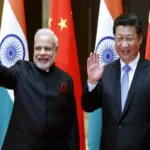
India and China have taken significant steps to ease tensions along their disputed Himalayan border, as confirmed by India’s top diplomat, Vikram Misri. This announcement comes in the wake of a series of violent clashes, including the deadly confrontations in the Galwan Valley, which marked the first fatal incidents between the two nations since 1975.
On Monday, Misri stated that both sides have reached an agreement on “patrolling arrangements” that aim to facilitate disengagement and address issues that emerged in 2020. The Galwan Valley incident, where troops engaged in brutal hand-to-hand combat using clubs and sticks, was a stark reminder of the fragile state of relations between the two nuclear-armed neighbors. This clash resulted in casualties on both sides and highlighted the potential for conflict in the region.

Misri’s remarks signal a hopeful development in a relationship that has been strained for several years. However, he did not elaborate on the specifics of the disengagement process or clarify whether it would encompass all points of conflict along the contested border.
The timing of this announcement is particularly notable, as it precedes Indian Prime Minister Narendra Modi’s upcoming trip to Russia for a BRICS summit, which includes Brazil, Russia, India, China, and South Africa. While Misri did not confirm any planned bilateral meeting between Modi and Chinese President Xi Jinping, the developments suggest a thawing in relations.
Tensions between India and China have persisted since the Galwan Valley clashes, with additional confrontations reported in the northern Sikkim area in 2021 and the Tawang sector in 2022. These incidents have often erupted due to the ambiguous nature of the 3,440 km (2,100-mile) border, which is marked by rivers, lakes, and snow-capped mountains that shift the Line of Actual Control (LAC). This geographical complexity frequently brings troops face to face, resulting in potential flashpoints.
The historical context of India–China relations is fraught with tension, including the brief but impactful war in 1962, which left India reeling from a significant defeat. Business ties between the two nations have also suffered as a result of ongoing hostilities, reflecting the broader implications of their strained relationship.

Furthermore, both countries have been engaged in a competitive infrastructure build-up along the border, which has added another layer of complexity to their interactions. The recent agreement on patrolling arrangements may pave the way for further dialogue and the possibility of reducing military presence in contentious areas.
As both nations move forward, the focus will be on how effectively they can implement these agreements and restore a sense of stability in the region. The potential for cooperation exists, but it will require continued dialogue and commitment from both sides to prevent future conflicts and foster a more peaceful coexistence.






Leave a Reply